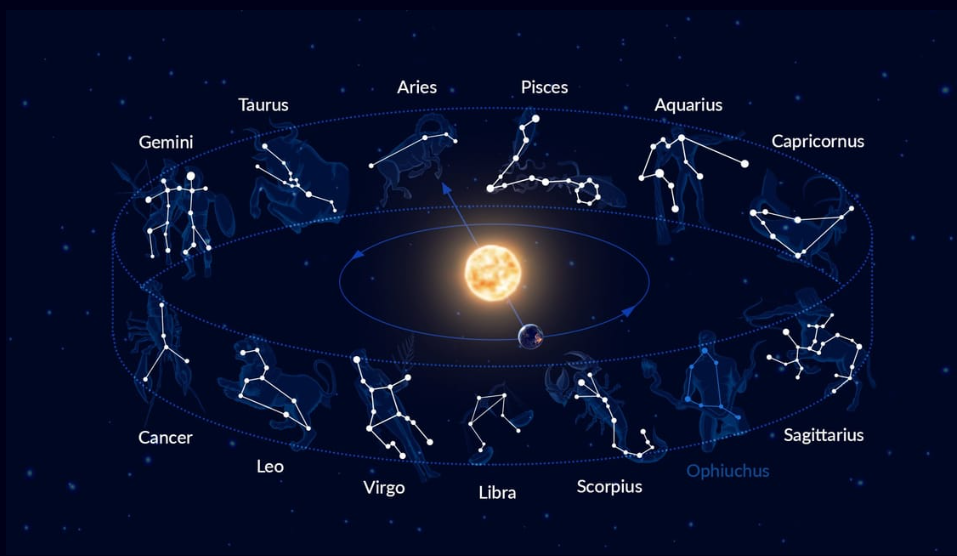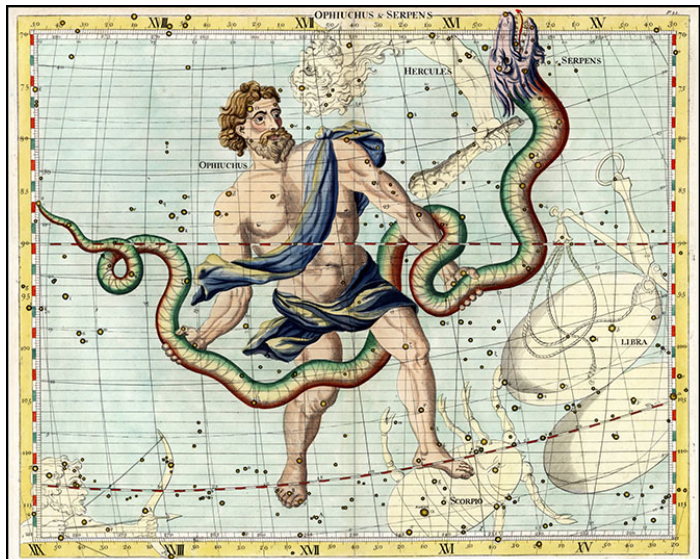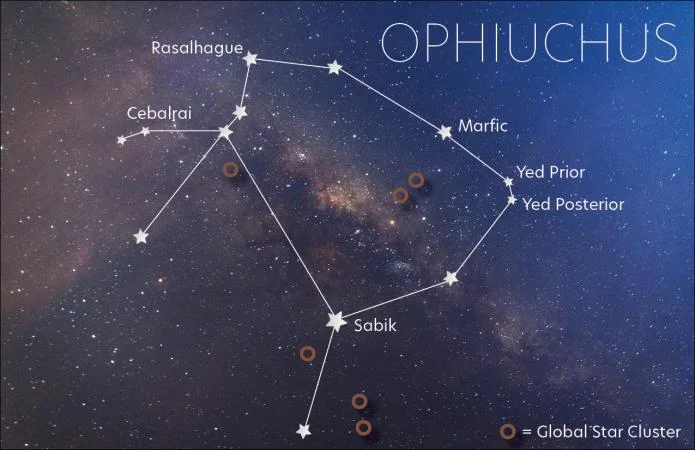Ophiuchus is named after the Greek words ophis (“serpent”) and cheiro-o (“to handle”).
“What is the numerical significance of the Clock People taking thirteen months to structure their ritual, then separating into thirteen families? Well, briefly, they consider thirteen a more natural number than twelve. To the ancient Babylonians, thirteen was unlucky. That is why, when they invented astrology, they willfully overlooked a major constellation, erroneously assigning to the zodiac only twelve constellations. The Clock People knew nothing of Babylonian superstition, but they knew the stars, and it was partly in an effort to override the unnatural twelve-mindedness of Western culture that they chose to give thirteen its due – Tom Robbins’ 1976 novel Even Cowgirls Get the Blues (p. 188).
Note: In Robbins’ novel, Even Cowgirls Get the Blues, the “Clock Keepers” were keepers of the keys to cosmic consciousness.
Constellation Ophiuchus
Ophiuchus is one of the 13 constellations that crosses the ecliptic. It is part of the astronomical zodiac but is not considered the “13th sign” of the astrological zodiac. Of course, there are a few astrologers who believe that Ophiuchus has revolutionized astrology. Some have even attempted to define Ophiuchus’ traits, but there’s little consensus even among those who use the “13th sign” as to its element, ruling planet, or even whether it’s masculine or feminine. All of which are used to help define the traits of the 12 astrological signs.
The Signs of the Zodiac and the Constellations
However, most astrologers do consider the mythology of the surrounding constellations to be an important part of the nature of the sign it backdrops (in this case Sagittarius.) So, Ophiuchus is not a forgotten astrological constellation. The Bottom line is that astrologers have always known about Ophiuchus, but that the signs of the astrological zodiac and the constellations are two entirely different things.
The Zodiac Constellations

The Sun’s time spent in each of the 13 constellations that touch the ecliptic varies because the constellations are different sizes and shapes:
Examples:
- The Sun spends only 7 days lined up with Scorpius
- The Sun spends 18 days lined up with Ophiuchus
- The Sun spends 45 days lined up with Virgo.
Astronomical Dates
Below are the astronomical dates when the Sun passes through the 13 ecliptic constellations. The dates may vary by a day, depending on the year and your time zone (source):
- Aries: April 19 – May 13;
- Taurus: May 14 – June 19
- Gemini: June 20 – July 20
- Cancer: July 21 – August 9
- Leo: August 10 – September 15
- Virgo: September 16 – October 30
- Libra: October 31 – November 22
- Scorpius: November 23 – November 29
- Ophiuchus: November 30 – December 17 (the Sun is in the astrological sign of Sagittarius from about November 22 until December 21)
- Sagittarius: December 18 – January 18
- Capricornus: January 19 – February 15
- Aquarius: February 16 – March 11
- Pisces: March 12 – April 18
The Ophiuchus and Serpens Constellations

Ophiuchus is usually depicted as an elderly man holding a snake in two hands. Often described as one constellation, Ophiuchus and Serpens is a dual constellation.
Serpens (the serpent) consists of two disconnected parts that are separated by Ophiuchus (the snake charmer). The duel constellations carry contradictory themes of kill or cure, both of which relate to periods of critical danger or change.
These constellations are intricately intertwined and can be seen in the dark sky of the northern hemisphere from June through October. They are centered on the equator and lie between the constellations of Scorpius and Sagittarius.
Ophiuchus Mythology: The Snake Charmer
Ophiuchus is generally identified as Asclepius. In Greek myth, Asclepius was the son of Apollo and Coronis, a woman who was married to someone else. Coronis was fatally wounded by an arrow from Artemis as punishment for her adultery. Apollo delivers his child from his dying mother while she’s on the funeral pyre and places him in the care of Chiron the Centaur.
Asclepius was to become so skilled that he raised a man from the dead. This angered Hades, the god of the underworld, who took his complaints to Zeus. Zeus then killed Asclepius with a thunderbolt and placed him in the sky as the Ophiuchus Constellation.
Hippocratic Oath
Asclepius is so pivotal to medicine that the original Hippocratic Oath begins:
“I swear by Apollo, the Physician, and Asclepius and Hygeia and Panacea and all the gods and goddesses, making them my witness, that I will fulfill according to my abilities, and judgment this oath…”
Serpens: The Snake
From the earliest records of civilization, the snake played a significant cultural role as a mystifying creature with supernatural powers – both good and bad. Snakes are alternatively seen as the benevolent creator, protector of wisdom, and eternal life, or as a perpetrator of evil and an agent of death. It’s a snake’s ability to shed its skin that also makes it a potent symbol of healing and regeneration.
The Rod of Asclepius
 Asclepius was taught the art of healing by Apollo, the god of healing. He was tutored by Chiron, the wise centaur (interestingly, the centaur is also associated with Sagittarius.) Asclepius was also taught by a serpent to use herbs to raise man from the dead.
Asclepius was taught the art of healing by Apollo, the god of healing. He was tutored by Chiron, the wise centaur (interestingly, the centaur is also associated with Sagittarius.) Asclepius was also taught by a serpent to use herbs to raise man from the dead.
Even today several well-known associations including The American Medical Association and The World Health Organization use the Rod of Asclepius with a snake wrapped around it as their symbol.
The Fixed Stars of Ophiuchus
Fixed Star Astrologers say the stars that seem to cause the most harm are those on the left side of Ophiuchus, especially around the figure’s left hand, which holds the forefront of the snake’s body.
Curiously, in one Asclepius myth, Athena, his aunt, had a vile in each of her outstretched hands when she visited to honor Asclepius. “These are my gifts to you,” she said. “They are filled with Gorgon blood. The blood in my left hand will kill, that in my right will heal.”
Unlucky Ophiuchus Stars
 The head star, Rasalhague, at 22°27′ Sagittarius is said by ancient astrologers to give misfortune through women, perverted tastes, drugs, poisoning, hallucination, and mental depravity. Islamic astrologers claimed a prominent Rasalhague indicated a snake charmer.
The head star, Rasalhague, at 22°27′ Sagittarius is said by ancient astrologers to give misfortune through women, perverted tastes, drugs, poisoning, hallucination, and mental depravity. Islamic astrologers claimed a prominent Rasalhague indicated a snake charmer.
The left knee, Sabik, at 17°58′ Sagittarius is said to cause wastefulness, lost energy, perverted morals, and success in evil deeds.
The left hand, Sinistra, which comes from the Latin word sinister is at 29°45′ Sagittarius. It’s thought to be immoral, mean, depraved, lustful, infamous, scandalous, and addicted to sorcery and poisoning
The back hand, Yed Posterior, is at 3°31′ Sagittarius. It is traditionally thought to be especially “evil” and is often associated with death.
Ophiuchus Meaning
Astrology King, who studies the Fixed Stars in the constellations writes:
“Constellation Ophiuchus is said to give a passionate, blindly good-hearted, wasteful and easily seduced nature, as well as unseen dangers, enmity, and slander.” The Ophiuchus myths and Stars reveal that love, betrayal, infidelity, birth, death, healing, and resurrection, as well as thunder and lightning, are all a part of Ophiuchus’ meaning.”
As Friedrich Nietzsche, the German philosopher, famously said “What does not kill you, makes you stronger”

